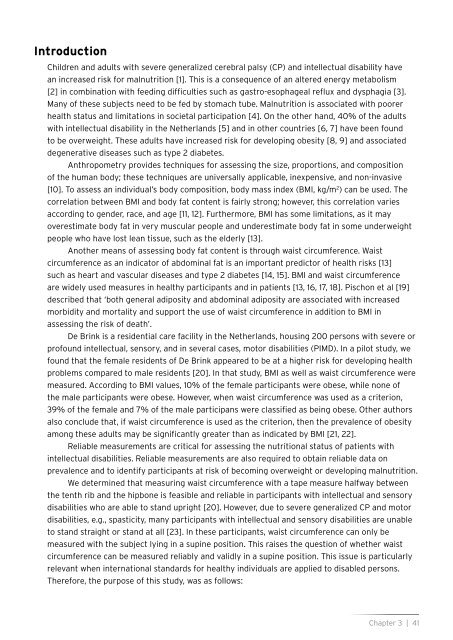Measuring physical fitness in Persons with Severe/Profound ...
Measuring physical fitness in Persons with Severe/Profound ...
Measuring physical fitness in Persons with Severe/Profound ...
- No tags were found...
You also want an ePaper? Increase the reach of your titles
YUMPU automatically turns print PDFs into web optimized ePapers that Google loves.
IntroductionChildren and adults <strong>with</strong> severe generalized cerebral palsy (CP) and <strong>in</strong>tellectual disability havean <strong>in</strong>creased risk for malnutrition [1]. This is a consequence of an altered energy metabolism[2] <strong>in</strong> comb<strong>in</strong>ation <strong>with</strong> feed<strong>in</strong>g difficulties such as gastro-esophageal reflux and dysphagia [3].Many of these subjects need to be fed by stomach tube. Malnutrition is associated <strong>with</strong> poorerhealth status and limitations <strong>in</strong> societal participation [4]. On the other hand, 40% of the adults<strong>with</strong> <strong>in</strong>tellectual disability <strong>in</strong> the Netherlands [5] and <strong>in</strong> other countries [6, 7] have been foundto be overweight. These adults have <strong>in</strong>creased risk for develop<strong>in</strong>g obesity [8, 9] and associateddegenerative diseases such as type 2 diabetes.Anthropometry provides techniques for assess<strong>in</strong>g the size, proportions, and compositionof the human body; these techniques are universally applicable, <strong>in</strong>expensive, and non-<strong>in</strong>vasive[10]. To assess an <strong>in</strong>dividual’s body composition, body mass <strong>in</strong>dex (BMI, kg/m 2 ) can be used. Thecorrelation between BMI and body fat content is fairly strong; however, this correlation variesaccord<strong>in</strong>g to gender, race, and age [11, 12]. Furthermore, BMI has some limitations, as it mayoverestimate body fat <strong>in</strong> very muscular people and underestimate body fat <strong>in</strong> some underweightpeople who have lost lean tissue, such as the elderly [13].Another means of assess<strong>in</strong>g body fat content is through waist circumference. Waistcircumference as an <strong>in</strong>dicator of abdom<strong>in</strong>al fat is an important predictor of health risks [13]such as heart and vascular diseases and type 2 diabetes [14, 15]. BMI and waist circumferenceare widely used measures <strong>in</strong> healthy participants and <strong>in</strong> patients [13, 16, 17, 18]. Pischon et al [19]described that ‘both general adiposity and abdom<strong>in</strong>al adiposity are associated <strong>with</strong> <strong>in</strong>creasedmorbidity and mortality and support the use of waist circumference <strong>in</strong> addition to BMI <strong>in</strong>assess<strong>in</strong>g the risk of death’.De Br<strong>in</strong>k is a residential care facility <strong>in</strong> the Netherlands, hous<strong>in</strong>g 200 persons <strong>with</strong> severe orprofound <strong>in</strong>tellectual, sensory, and <strong>in</strong> several cases, motor disabilities (PIMD). In a pilot study, wefound that the female residents of De Br<strong>in</strong>k appeared to be at a higher risk for develop<strong>in</strong>g healthproblems compared to male residents [20]. In that study, BMI as well as waist circumference weremeasured. Accord<strong>in</strong>g to BMI values, 10% of the female participants were obese, while none ofthe male participants were obese. However, when waist circumference was used as a criterion,39% of the female and 7% of the male participans were classified as be<strong>in</strong>g obese. Other authorsalso conclude that, if waist circumference is used as the criterion, then the prevalence of obesityamong these adults may be significantly greater than as <strong>in</strong>dicated by BMI [21, 22].Reliable measurements are critical for assess<strong>in</strong>g the nutritional status of patients <strong>with</strong><strong>in</strong>tellectual disabilities. Reliable measurements are also required to obta<strong>in</strong> reliable data onprevalence and to identify participants at risk of becom<strong>in</strong>g overweight or develop<strong>in</strong>g malnutrition.We determ<strong>in</strong>ed that measur<strong>in</strong>g waist circumference <strong>with</strong> a tape measure halfway betweenthe tenth rib and the hipbone is feasible and reliable <strong>in</strong> participants <strong>with</strong> <strong>in</strong>tellectual and sensorydisabilities who are able to stand upright [20]. However, due to severe generalized CP and motordisabilities, e.g., spasticity, many participants <strong>with</strong> <strong>in</strong>tellectual and sensory disabilities are unableto stand straight or stand at all [23]. In these participants, waist circumference can only bemeasured <strong>with</strong> the subject ly<strong>in</strong>g <strong>in</strong> a sup<strong>in</strong>e position. This raises the question of whether waistcircumference can be measured reliably and validly <strong>in</strong> a sup<strong>in</strong>e position. This issue is particularlyrelevant when <strong>in</strong>ternational standards for healthy <strong>in</strong>dividuals are applied to disabled persons.Therefore, the purpose of this study, was as follows:Chapter 3 | 41











